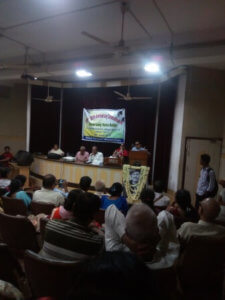Rape of the Lock by Alexander Pope is now available in Braille. This book is completed in two Braille volumes. The poem has a very good introduction and notes by the editor, Geoffrey Tillotson. Since it is on the syllabuses of almost all colleges, this edition will be of great use to Braille-reading students. The total price of the book is Rs. 178. Students may collect it for Rs. 20 only. Visit our for details.
About Rape of the Lock
Rape of the Lock by Alexander Pope is a representative literary work of the Augustan Age. The Augustan Age or the eighteenth century English literature was marked for its favouring satire in both poetry and prose. The purpose of the satirical writing was to attack the superficial conduct and values of the fashionable urgan society. Pope’s tone in the Rape of the Lock hardly seems sharp and stinging. One reason behind it may be that the poet considered himself as one of the society and he himself is in love with the society.
The poem was inspired by the cutting of lock by Lord Petre from the head of her distant relative, Miss Arabella Fermor. The incident took place at Hampton Court in 1711 and the victim was a renowned beauty. The social repercussion, Pope later admitted, “caused an estrangement between the two families, though they had lived so long in great friendship before.” Pope wrote the poetry on suggestion from John Caryll, his friend and patron, and a mutual friend of both families “to make a jest of it, and laugh them together again.” As common to epic poetry, The poet begins with an invocation (I 3) to Caryll, his muse.
The plot is ridiculous. The satiric tone is robust and vigorous and indicates the shallowness of the society.
What dire Offence from am'rous Causes springs,
What mighty Contests rise from trivial Things,
I sing—This Verse to Caryll, Muse! is due;
This, ev'n Belinda may vouchsafe to view:
Slight is the Subject, but not so the Praise ...
(I 1-5)
Pope’s heroine Belinda is a pervect coquet. Though she outwardly maintains a chaste and pure appearance, she secretly desires attention from young gentlemen at parties. His list of the articles on Belinda’s dressing table, “Puffs, Powders, Patches, Bibles, Billet-doux” (I 138) exposes the moral ambiguity of the woman of honour who equally treats her toiletries, Bible and her love letters. The woman may be innocent, but she is extremely vulnerable. The humour in the narrative points to the vulnerability of women in the society.
What tender Maid but must a Victim fall
To one Man's Treat, but for another's Ball?
When Florio speaks, what Virgin could withstand,
If gentle Damon did not squeeze her Hand?
With varying Vanities, from ev'ry Part,
They shift the moving Toyshop of their Heart; ...
(I 95-100)
It would be unfair if we assume that Pope criticized Women’s follies only. He questioned his hero’s vulgar sense of value as well.
But chiefly Love—to Love an Altar built,
Of twelve vast French Romances, neatly gilt.
There lay three Garters, half a Pair of Gloves;
And all the Trophies of his former Loves.
With tender Billet-doux he lights the Pyre,
And breathes three am'rous Sighs to raise the Fire.
(II 37-42)
Rape of the Lock adopts conbventional epic features as a mock-heroic poem – epithets, similes, metaphors, anticlimaxes and so on. The effect is further enhanced by Heroic couplet and iambic pentameter. Mock epic riducules an epic by treating a trivial thing with something great. It has journey by the river Thames, the game of ombre and the use of sylphs as guardian angels for its traditional epic devices. The cutting of the lock takes it to its climax. The juxtaposition of the trivial and the sublime is dominant throughout the poem.









